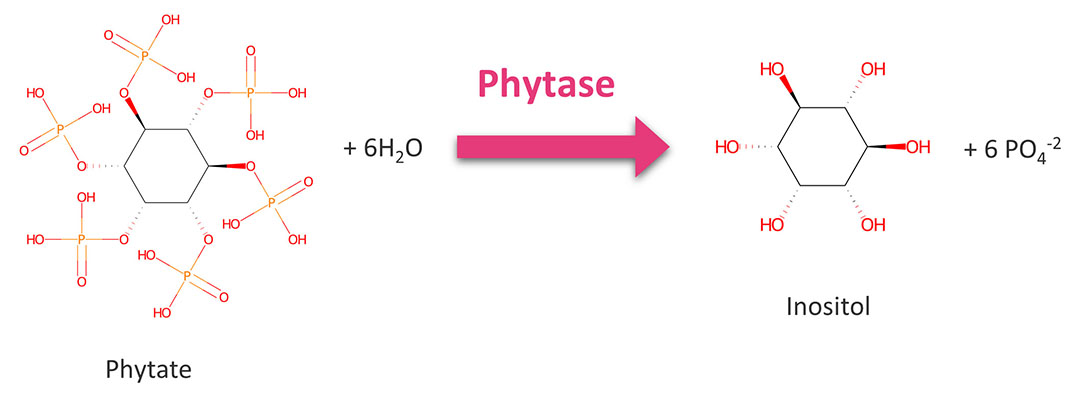Summary
Phytase is an enzyme that makes the phosphorus from phytin available for animal digestion. It has been mainly used as a dietary supplement for swine and poultry. The benefits of phytase are its double effects on reducing the use of expensive inorganic phosphorus in animal diets and the environment pollution from excessive manure phosphorus runoff.
They have emerged as prominent feed enzymes to enhance the utilization of phosphate, which is 85–90% bound in phytic acid. they also diminish the release of phosphate as a pollutant into the environment. Since the recognition of bovine spongiform encephalopathy (BSE), certain countries have banned the use of bone meals in feeds, which was a traditional source of phosphorous, and this policy has enhanced their use. Phytases have also been found to increase the uptake of other nutrients, especially essential metals
Phytic acid
the phytic acid, also named phytate which is a compound made throughout the process maturation of grains and plant seeds. About 2/3 of phosphorus is present within plant based foods like wheat, grains and cereal. Minerals like magnesium, zinc, calcium and iron are typically known to be charged with positive ions within phosphate. Additionally, magnesium, calcium, iron and zinc are liberated which makes these essential minerals much more available.
Myo-inositol hexakisphosphate is known as phytic acid (phytate), is the storage form of phosphorus in plants (70–80% in seeds). Myo-inositol ring carrying six phosphates group and represent high negative charge in the pH of the digestive tract of monogastric animals (Kumar et al., 2015). The non-ruminants are incapable of degrading phytic acid, therefore in addition to reduce phosphorous bioavailability, phytate could chelate essential cations such as Fe2 +, Mg2 +, Ca2 +, Cu2 + and Zn2 + which makes the phytate an anti-nutrient component. Additionally, undigested phytate could enrich waters and lead to algal growth and eutrophication
Phytic acid (Inositol Hexaphosphate- IP6) is a low solubility compound present in broiler feed. It has an anti-nutritive factor as Phosphorus is present in it in a bound form that decreases its availability in the body. To compensate for the deficiency of Phosphorus, additional phosphorus in the form of Dicalcium Phosphate is added in the diet that leads to an increase in feed cost. Moreover, the bound Phosphorus passed from excreta without being absorbed, damages the environment, and depletes the non-renewable resources from which Phosphorus is extracted.
Phytic acid gets complexed with protein, starch, and other minerals, thus reducing their availability to the animal. This property to chelate with various important compounds makes the Phytic acid to withstand further digestion. To overcome this problem exogenous phytase in feed is incorporated. But recently Phytase superdosing i.e. use of high doses of enzyme phytase with growth-promoting effects is being widely accepted. In this article, the science behind superdosing and how it helps to increase animal performance is discussed.
Exogenous phytase
Myo-inositol hexakisphosphate is known as phytic acid (phytate), is the storage form of phosphorus in plants (70–80% in seeds). Myo-inositol ring carrying six phosphates group and represent high negative charge in the pH of the digestive tract of monogastric animals (Kumar et al., 2015). The non-ruminants are incapable of degrading phytic acid, therefore in addition to reduce phosphorous bioavailability, phytate could chelate essential cations such as Fe2 +, Mg2 +, Ca2 +, Cu2 + and Zn2 + which makes the phytate an anti-nutrient component. Additionally, undigested phytate could enrich waters and lead to algal growth and eutrophication.

In order to overcome the problems as mentioned earlier, Phytase enzymes are added to the animal diets. Phytase enzymes are capable of removing the phosphates from phytate. This enzyme derived from plants, animals and microorganisms. Among them, most scientific and industrial work has been conducted on microbial phytases, which showed 40% bio-efficiency more than plant-derived phytases
The genetic advancements for the thermo-stability of the phytase were the top priority in the industry in the past decade. Now the industry is focusing on advanced methodologies to optimise the phytase function and stability by structural modifications such as carboxylated multi-wall nanotube (MWNT) with phytase covalent attachment, adjustment of Sulphur-containing amino acids (eg: cysteine, taurine), and adjustment of ions and chemical reagents. Novel advancements of functional modern feed enzymes are gradually increasing in the market due to high competition and demand.
Health benefits
In nature people can find phytase in animals, plants and microorganisms. The primary foundation of the commercially available phytase is known to be fungal, even though yeast phytase and bacterial have been additionally discovered. Phytase was considered a medical breakthrough back in the 90s when it used to be the key driver for reducing phosphorus excretions in poultry and pigs. The enzyme can now boost digestibility, protein and amino acid accumulation.
It can also:
Decrease phytic acid within the body
Boost mineral bioavailability and absorption
Trim down mineral deficiency
Reduce toxic build-up within the digestive tract
Increase bone health
Hew bound phosphorus within the human body
Key Reference
1. Superdosing of Phytase – A concept to increase animal performance







